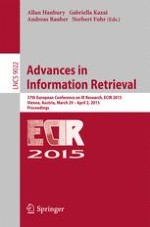This book constitutes the proceedings of the 37th European Conference on IR Research, ECIR 2015, held in Vienna, Austria, in March/April 2015. The 44 full papers, 41 poster papers and 7 demonstrations presented together with 3 keynotes in this volume were carefully reviewed and selected from 305 submissions. The focus of the papers were on following topics: aggregated search and diversity, classification, cross-lingual and discourse, efficiency, evaluation, event mining and summarisation, information extraction, recommender systems, semantic and graph-based models, sentiment and opinion, social media, specific search tasks, temporal models and features, topic and document models, user behavior and reproducible IR.
